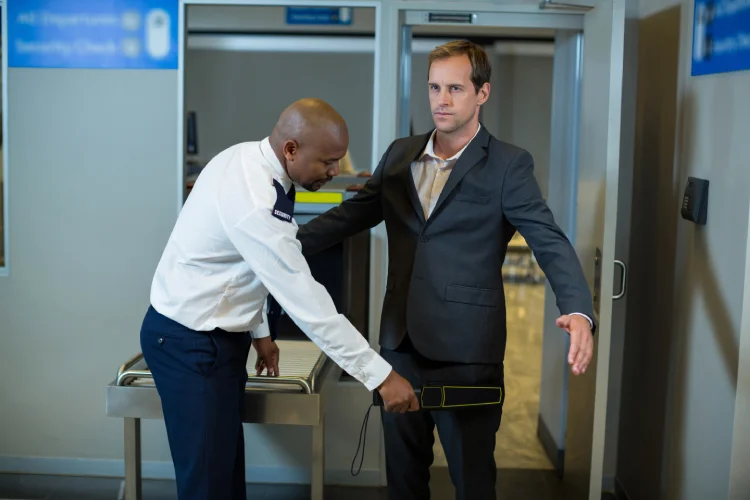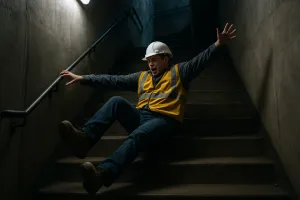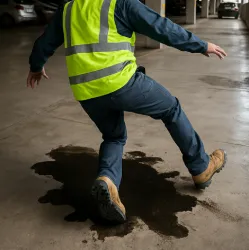High-Risk Zones (Entrances, Stairwells, Car Parks)
Not all areas of a site carry the same risks. As a security officer, you’ll know that some zones demand extra attention because slips, trips, and falls are more likely to occur there. Entrances, stairwells, and car parks are all high-risk zones, and your vigilance in these spaces makes a direct difference to safety, compliance, and professionalism.
Why These Zones Matter
According to the Health and Safety Executive (HSE), slips and trips are responsible for over 30% of all major workplace injuries in the UK. Many of these happen in high-traffic or poorly managed zones such as building entrances, stairwells, and car parks.
Standards like BS 7499 (Guarding Services) and NSI Guarding Gold highlight the importance of routine patrols and hazard awareness. Your SIA licence places a duty on you to act responsibly, while the Health and Safety at Work Act 1974 makes it clear that employers and employees share responsibility for keeping workplaces safe.
Tip: When on patrol, think about where accidents are most likely to happen — those are the areas where your attention matters most.
Entrances – First Impressions and First Risks
Entrances are busy, high-footfall areas where hazards quickly build up:
Rainwater and mud tracked inside create slippery surfaces.
Mats and rugs can curl or slip if not secured properly.
Crowds and queues mean people may not see hazards ahead.
Scenario: On a wet winter morning, rainwater is pooling near the front doors of an office building.

Right action: Place a warning sign, call cleaning support, and monitor until safe.
Wrong action: Leave it, assuming the cleaner will deal with it later. A visitor slips, injures their back, and the business faces a claim.
Tip: Treat entrances like a spotlight zone — they’re where most visitors arrive, and their safety shapes the site’s reputation.
Stairwells – Small Mistakes, Big Consequences
Stairs are naturally high-risk because falls here are often serious:
Poor lighting makes steps harder to see.
Worn or uneven steps can cause trips.
Clutter like boxes or bags can block the way.
Handrails missing or loose increase risks.

Scenario: During a night patrol, you spot that a stairwell light has failed.
Right action: Report it immediately and restrict access if possible until fixed.
Wrong action: Ignore it until morning. A contractor trips in the dark, leading to injury and an HSE investigation.
Tip: Always check stairwells during patrols — think of them as “red flag areas” where hazards escalate quickly.
Car Parks – Wide Spaces, Hidden Hazards
Car parks may look open and simple, but they contain multiple slip and trip risks:
Oil spills or puddles make surfaces slippery.
Loose gravel or uneven paving cause trips.
Poor lighting reduces visibility and increases risk.
Weather conditions (ice, snow, rain) turn car parks into danger zones.
Scenario: You’re on duty at a shopping centre. Overnight ice has formed near the staff entrance.

Right action: Block access to the icy area, request gritting, and inform staff of the hazard.
Wrong action: Do nothing. An employee slips, suffers a fracture, and the employer is fined for failing to provide safe access.
Tip: Remember, car parks are often the first and last area people see. Keeping them safe reflects professionalism and builds trust.
Real-World Example – The Hotel Slip
It’s a cold, rainy evening at a busy city hotel. Guests are rushing in for a conference, umbrellas dripping water onto the shiny marble entrance. Within minutes, the floor becomes slippery.
A vigilant security officer notices the risk.
He quickly places a wet floor sign, radios housekeeping, and politely directs guests around the affected area until it is cleaned.
Result: No accidents, and guests see the officer as proactive and professional.
Now imagine the opposite: the hazard is ignored. A guest slips, injures their hip, and the hotel faces:
An injury claim running into thousands of pounds.
An HSE investigation for failing to provide a safe environment.
Loss of trust in both the business and the security team.
Tip: Quick, simple actions in high-risk zones can prevent accidents and protect reputations.
High-Risk Zones at a Glance
| Zone | Key Hazards | Officer’s Action |
|---|---|---|
| Entrances | Rainwater, mud, loose mats, crowding | Place mats/signs, monitor conditions, call cleaning support |
| Stairwells | Poor lighting, worn steps, clutter, broken handrails | Report faults, keep clear, restrict access if unsafe |
| Car Parks | Oil spills, ice, poor lighting, uneven surfaces | Patrol regularly, arrange gritting/clean-up, log hazards |
Consequences of Ignoring High-Risk Zones
For Employers: HSE penalties, compensation claims, reputational harm.
For Security Officers: Loss of trust, possible SIA licence risk, disciplinary action.
For Staff and Visitors: Painful injuries, lost working time, shaken confidence in safety.
How to Stay on Top of High-Risk Zones
Entrances: Check mats, monitor for water, act quickly in bad weather.
Stairwells: Inspect lighting, keep clear, ensure handrails are secure.
Car Parks: Patrol regularly, watch for oil, ice, and poor lighting.
Always record hazards: Logging your actions shows compliance with standards like BS 10800 and NSI Guarding Gold.
Tip: Make high-risk zones your “priority checkpoints” on every patrol — small actions here prevent big accidents.
What Security Officers Should Keep in Mind
High-risk zones aren’t optional checks — they are your frontline defence against slips, trips, and falls.
Your vigilance is the difference between a safe site and an accident waiting to happen.
Action equals compliance — every hazard you spot and report aligns with SIA, HSE, BSI, and NSI standards.
Professionalism shows in the details — clients notice when officers are proactive in protecting people.
Final Tip: Every time you prevent an accident in a high-risk zone, you’re not just keeping people safe — you’re proving your value as a professional security officer.

